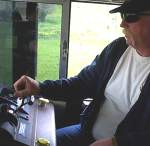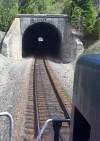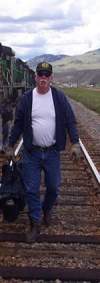 Tuesday, June 29, 1999, From Missoula, Montana, to Helena and back -
He drives the largest thing on land - sometimes over a mile and a quarter long - a screaming, roaring, heavy-steel part of history. Tom Talburt is an engineer for the railroad.
Tuesday, June 29, 1999, From Missoula, Montana, to Helena and back -
He drives the largest thing on land - sometimes over a mile and a quarter long - a screaming, roaring, heavy-steel part of history. Tom Talburt is an engineer for the railroad.

 America owes itself to trains. They helped build the western frontier, they moved people long before airplanes, they carried troops during wars, and they supply our country with goods every single day. Trains have been immortalized in motion pictures, books and songs, and have been a great part of our lives, even though we rarely see them.
America owes itself to trains. They helped build the western frontier, they moved people long before airplanes, they carried troops during wars, and they supply our country with goods every single day. Trains have been immortalized in motion pictures, books and songs, and have been a great part of our lives, even though we rarely see them.
|
Runaway Train

I never thought I'd see the day, but I am actually at the controls of a railroad locomotive. I have the throttle in one hand, the brake in the other - and I even get to blow the horn! Jim Maxson, an engineer for ten years, is right behind me, instructing me, as we head over the continental divide on our way from Helena, to Missoula, Montana.

"Bring it up to three," Maxson says, referring to the brake lever.
"I am now... at three, and doing 32 miles an hour," I reply, as though I'm on the bridge of the Enterprise.
We are hauling a string of cars and engines that weighs over 8 million pounds, and is more than two-thirds of a mile long. When it runs smoothly, and nothing is in the way, it is a beautiful, enormous machine, but when something goes wrong, it is a monster. This job is called "running" the train, but it is all about stopping the train.
There are hundreds of brakes on this train, and four controls. One for air brakes on all of the cars, one for air brakes on the engine. One, called the "dynamic brake" uses the train's motor to slow the engine's wheels, like downshifting a car. The fourth brake control is "emergency" and hitting this button will lock everything up. Even when you do this, if cars don't fly off the tracks, it can take up to a mile to stop this thing. Maxson once hit a pickup truck, while doing 60 mph. He hit just the corner of the truck, and the driver, who had jumped a crossing, got off with a bruised head - if not soiled pants.
As I apply the dynamic brake - the brake used most often by engineers - I can feel the train slowing, gradually. We pass through the speed zone, and I slide the speed lever to the right and we begin moving faster. I have never had this much power in my hands - I am running something that weighs thousands of times as much as a fully-loaded Suburban, and is longer than 13 football fields.
As we approach a crossing, I lean on the horn - two long blasts, one short, and two more long. All this, while I have the bell clanging away. This is a dream job for guys who love to make noise.
We head up a grade, and Maxson has me hit the "sand" switch, sending a spray of sand to the power wheels, so they grip the rails better.
Maxson joined the railroad three decades ago, to earn money for college, and he just stayed on. At 53 years old, he still enjoys the job; "There's no one bugging you out here," he says. "And I like to watch the change of the seasons. I like watching the northern lights." But he wouldn't recommend this job, even to his son, who, instead of taking for a train ride for inspiration, he took to see the Navy Blue Angels jet pilot team. Maxson has been through two marriages, but doesn't blame their ruin on the railroad. "It's my choice in women," he says.
We pass an inspection point, and a computer radios results to us. A digitized voice tells me; "57 degrees, 232 axles - No defects." The temperature, in celsius, is of the steel wheels, and if they get too hot, it could mean brake failure.
The lights on the next pole - a solid green and solid red - indicate a "clear block" meaning we have no traffic in the next few miles. Railroads are divided into block segments and are controlled that way. If you see a flashing red light on one of these, you know a train is somewhere nearby.
Maxson lets me run the train up to the divide, and then he takes over. Running a train uphill is a lot easier than downhill (see "braking.") I just pulled 47 carloads of goods about 30 miles. If these were pulled by trucks, it would have meant at least that many trucks and truck drivers. Trains can pull well over 100 cars, and as much as 140 at one time. I am pretty pleased with my accomplishment as I surrender the engineer's seat.
|
Talburt is an engineer for Montana Rail Link, one of three railroads owned by Dennis Washington, who is one of very few private railroad owners left in America. With 937 miles of rail, between Billings, Montana, and Sand Point, Idaho, M.R.L. moved over 200,000 carloads of freight last year. Today, Talburt is running an SD70 Mac locomotive, with 4,000 horsepower. It weighs 415,000 pounds and holds 4,400 gallons of
fuel. (My motorcycle weighs 800 lbs. and holds 5 gallons.)
 Tom Talburt - "It makes sense that you do what your father did - I wish he was a race car driver!"
Tom Talburt - "It makes sense that you do what your father did - I wish he was a race car driver!"
|
Tom Talburt remembers riding a train when he was only a few years old. His father, a passenger train engineer, would put him on his lap on the run out of Wichita, Kansas. This was the start of a great thing, and Talburt has followed in his father's rails.
"Every trip is different," says Talburt, explaining why he enjoys his job. He always rides the same track, but he will usually have different sized loads, which can make the run either a challenge or a pleasure. Sometimes he has to pick up cars along the way, and sometimes drop some off. Around here, the seasons change dramatically, and give the engineer a show as he rolls through the mountains, along the switchbacks and over the trestles.
The rough part of this job is the hours. They aren't long hours, necessarily - limited to a 12-hour shift with at least 8 hours off - but they are crazy hours. "A train engineer is on call 24 hours a day, 7 days a week," Talburt says. "He must be ready to go in 2 hours." Unlike passenger trains, which run on a schedule, freight trains run whenever and wherever there's freight, and usually there is freight at night.
Add to this, the fact that trains run only one-way, and you have a real mess. An engineer will make a run to a city hundreds of miles away, then wait in a hotel to either catch another train back or be driven home. This layover adds several hours to a run - as much as 16 before they are paid extra. "I would not recommend it to anyone, because of the hours," says Talburt.
 Jeff Weeks
Jeff Weeks
|
Jeff Weeks, the railroad's Train Master, and my escort today, shows me the Wheel Report, which tells me that our train is 2,852 feet long and weighs 3,009 tons. The "wheel" as they call it, is a computer printout listing everything on this train, including hazardous materials, for which it gives emergency instructions. Weeks began his railroad career nearly two decades ago, in Oklahoma, and just recently left the engineer's seat - he now manages engineers.
 As we approach Mullan Tunnel, I climb out on the foredeck for a photo. It is a harrowing, thrilling ride, because that little tunnel doesn't look nearly large enough for this train, but we safely rush into the darkness. Not more than a quarter of the way in, the train slows down and stops. Weeks sticks his head out. "The train's in emergency," he says. "Better come in." This tunnel is nearly a mile long, and unventilated, and engines tend to overheat in here, and then they partially shut down and cool off. This can get dangerous, after a while, but we are up and running again in minutes.
As we approach Mullan Tunnel, I climb out on the foredeck for a photo. It is a harrowing, thrilling ride, because that little tunnel doesn't look nearly large enough for this train, but we safely rush into the darkness. Not more than a quarter of the way in, the train slows down and stops. Weeks sticks his head out. "The train's in emergency," he says. "Better come in." This tunnel is nearly a mile long, and unventilated, and engines tend to overheat in here, and then they partially shut down and cool off. This can get dangerous, after a while, but we are up and running again in minutes.
WORKING ON THE RAILROAD
Engineer - Runs the train
Asst. Engineer - Monitors the train
Yardmaster - Lines up cars
Switch Crew - Help the Yardmaster
Road Master - Track Maintenance
Road Foreman - Supervises Engineers
Train Master - Supervises Engineers
Dispatcher - Manages train movement
|
An engineer's life can also be hard on an engineer's wife. "When I move to another railroad, I have a ready-made family, but the wife doesn't," Talburt says. "It can take a few years for her to get settled into a new city." Talburt became a railroad engineer in 1971 in Kansas City, Missouri. He moved to Wyoming for a while, then to Montana in 1987. "I dragged my wife through five different railroads," he says.
Another regret of his job is that the track runs through thick forest land, and he has hit many animals, including; deer, elk and even bear. Engineers sound their horns and bells and flash their lights to startle animals, but many times they end up on the side of the tracks, as food for the rest of the kingdom. Three years ago, a man dropped himself in front of Talburt's train. Talburt knew he hit something, but he wasn't sure what, as the impact was so sudden. The next day, they found the body, and Talburt believes the event was a suicide. These are the things a train engineer has to live with. Engineers fear only big things, the things that mean certain death for somebody, with no effective plans for prevention. You can safeguard to no end, but there will always be the chance that something may step in front of you, or give way beneath you.
 At age 49, Talburt doesn't feel like he has the same career as his father had; "It seems like, my dad was respected in the community," he says. "But now, you don't get much respect as an engineer." He is not about to switch careers, however. "You reach the point of no return," he says. "I've been doing this for 30 years - I'm not an electrician, I'm not a carpenter, so I'm stuck."
At age 49, Talburt doesn't feel like he has the same career as his father had; "It seems like, my dad was respected in the community," he says. "But now, you don't get much respect as an engineer." He is not about to switch careers, however. "You reach the point of no return," he says. "I've been doing this for 30 years - I'm not an electrician, I'm not a carpenter, so I'm stuck."
Stuck, that is, with a beautiful 1965 Corvette in his driveway, and plans to retire at the fairly young age of 55. If you can put up with the hours, the job pays rather well. "My dad worked for 42 years, and then he retired," he says. "Then he died a year and a half later. I want to enjoy my retirement."
 Electric Trains. Technology has improved greatly, even in the past three decades. Computers help keep schedules efficient and trains from colliding. An "alerter" system will sound an alarm unless Talburt presses its button every 60 seconds. The monitor at right replaces many gauges and tells the engineer everything from speed, to the condition of his engine and braking system. This has eliminated the need for a caboose and for two crewmen to ride back there and keep watch over the train - modern trains run with only two crew members. Most trains today are actually powered by huge, electric motors, which run off of electricity produced by a diesel engine.
Electric Trains. Technology has improved greatly, even in the past three decades. Computers help keep schedules efficient and trains from colliding. An "alerter" system will sound an alarm unless Talburt presses its button every 60 seconds. The monitor at right replaces many gauges and tells the engineer everything from speed, to the condition of his engine and braking system. This has eliminated the need for a caboose and for two crewmen to ride back there and keep watch over the train - modern trains run with only two crew members. Most trains today are actually powered by huge, electric motors, which run off of electricity produced by a diesel engine.
Every mile they run, they run on faith; faith that the track is in good shape, faith that the switches will set properly, that there isn't another train mistakenly headed their way, and that some joker won't try to jump the crossing.
 There is a lot of preparation behind this faith. The Road Master and his crew inspect the tracks regularly, computer programs and fail-safe procedures ensure against collisions, and the horn he blows at crossings is really, freaking loud. But there is always that knowledge that something can go wrong, and when something does go wrong, it can easily go dead wrong.
There is a lot of preparation behind this faith. The Road Master and his crew inspect the tracks regularly, computer programs and fail-safe procedures ensure against collisions, and the horn he blows at crossings is really, freaking loud. But there is always that knowledge that something can go wrong, and when something does go wrong, it can easily go dead wrong.
They call it "the road" which doesn't make sense to a layman, because we drive cars on the road. But then, you realize that it is a road of rails, and that this road existed a century before the automobile, and then it does make sense. So they ride their huge machines of thunder, down that road made of steel, into the nights and through our cities and towns, and they do the jobs of a hundred men, for hour after lonely hour, and this is their lives; the life of the railroad engineer.
|



